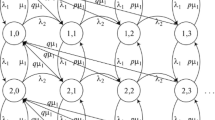Abstract
A digital data acquisition system is analyzed under the traffic standpoint. This system receives a random stream of digital messages, accumulates them in an electronic buffer storage and unloads them on a magnetic tape. The system is representable as a single waiting line, the service mechanism of which is ruled by the characteristics of the cascaded functional blocks. Queueing theory methods are applied to determine the queue length distribution under stationary conditions as a function of the system parameters; this, conversely, provides some criteria for the selection of the values of the parameters, necessary to achieve a given statistical behavior. The expected message loss due to temporary system saturation is also computed.
Similar content being viewed by others
References
D. G. Kendall, «Some Problems in the Theory of Queues», Jour. Roy. Stat. Soc., B, XIII 1951, No. 2, 151–185 (1951).
W. Feller, «An Introduction to Probability Theory and Its Applications,» Vol. 1, John Wiley & Sons, Inc., New York, 1957.
H. H. Goode andR. E. Machol, «System Engineering,» McGraw-Hill, New York; 1957.
Author information
Authors and Affiliations
Rights and permissions
About this article
Cite this article
Preparata, F. Traffic analysis of a buffered digital data acquisition system. Calcolo 3, 113–126 (1966). https://doi.org/10.1007/BF02576746
Received:
Issue Date:
DOI: https://doi.org/10.1007/BF02576746




